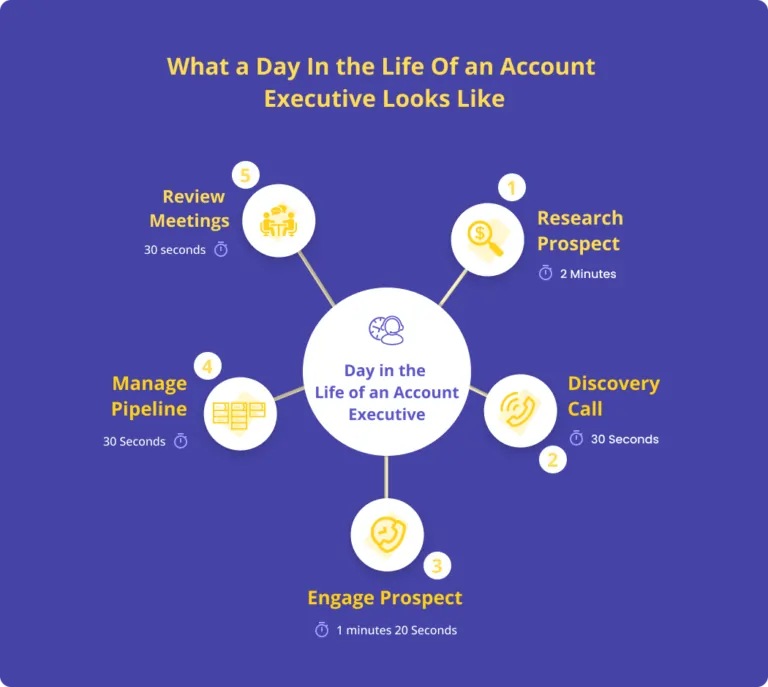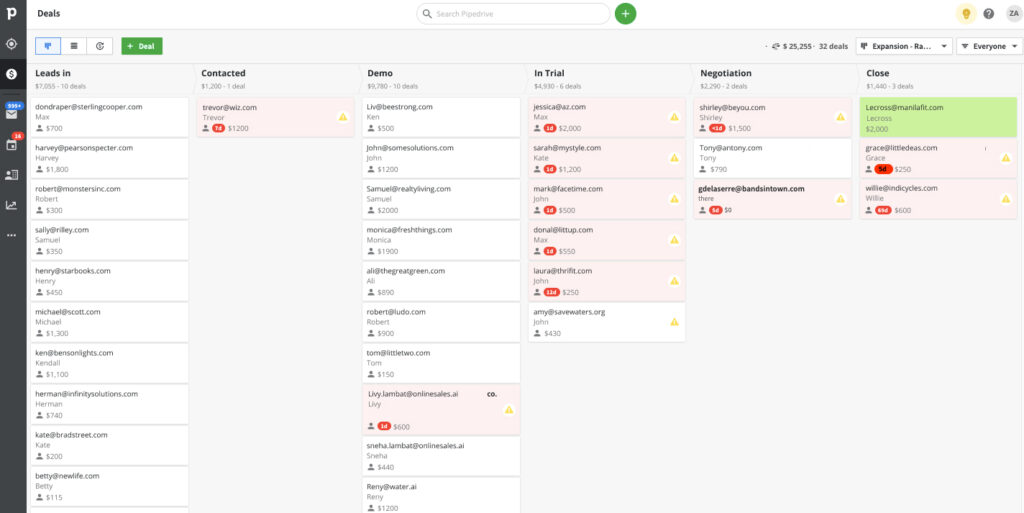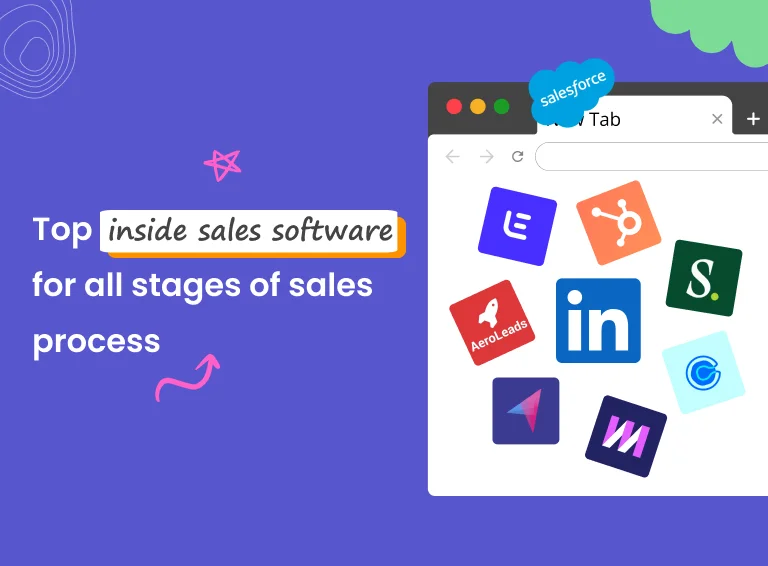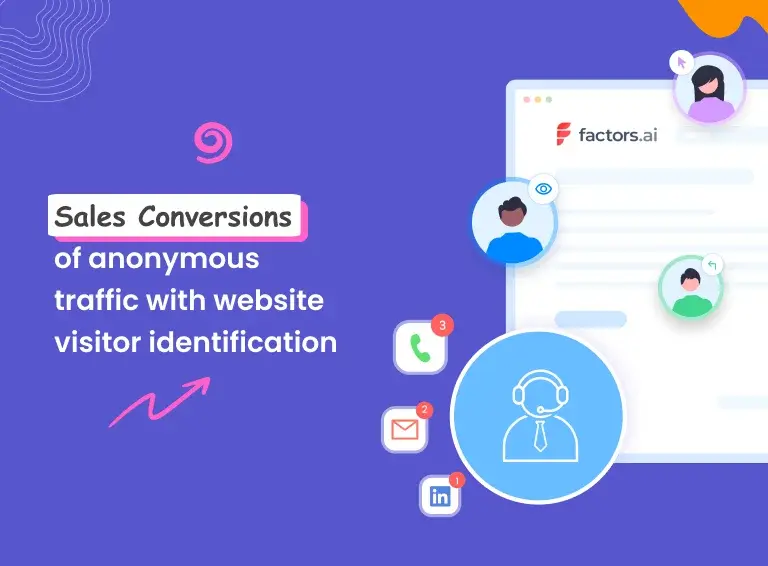Think of an account executive.
What came to your mind?
Is it the suit-clad guys from Mad Men?
The guy who can sell you a pen?
The person who’s loudly selling a dream to someone on the other end of the phone while they vigorously squeeze a stress ball in their hand?
Or is it Will Smith selling himself for a job dressed in paint splatters and a shoddy grey bomber jacket?
They’re all salespeople existing in the fictional universe of entertainment. All of them are portrayed as wickedly smart, efficient, and super-stressed.
Rightly so.
Simply because they are salespeople who close deals. They bring in the money for the business.
And in today’s evolved sales playground, the salespeople who close deals are called Account Executives (AE).
In short, AEs play a crucial role in pushing the sales process forward. Here's a snapshot of what we've written for you.
Who Is an Account Executive?
An Account Executive in the sales world is a salesperson who is responsible for closing deals. AEs are salespeople who have revenue targets to hit. By continuously engaging with leads via email or call, AEs aim to convert opportunities in the sales pipeline to closed deals.
Where Do They Fit in the Sales Process?
In the SaaS industry’s specialized sales team, there are three key people who convert prospects to leads, leads to customers, and customers to returning customers.
- SDR: SDRs look for prospects who match the ideal customer profile, conduct a preliminary qualification of the prospect, and book meetings with them for the account executive to take over.
- Inbound SDR: SDRs reach out to prospects who are brought in by the marketing team.
- Outbound SDR: SDRs reach out to prospects who have not been contacted before and have no knowledge about you or your business.
- Account Executive (Inside Sales): AEs are the quota-carrying members of the sales team responsible for engaging with the leads in the pipeline and closing deals.
- Customer Sucess Specialist: CSS is responsible for retaining existing customers, and up-selling to them.
What Does an Account Executive Do:
1. Qualify Leads
The Account Executive sets up a discovery call with leads to know more about their needs and wants. At this stage, AEs have prepared a list of questions to qualify the prospect. A lot of time and effort is spent on lead qualification because it’s essential AEs focus on the right opportunities.
If you’ve ever listened to a discovery call, it’s usually filled with a lot of buts, and hmmms. Not all prospects come in with a detailed list of problems they want to solve or a clear idea of what kind of solution they need. The responsibility to uncover the roots of their problem falls on the AE. Finding out what their expectations of the product are, the kind of problems they want to solve, and their biggest pains will help an AE to
- Vet the prospect
- Sell the solution better
AEs adopt lead qualification methodologies like BANT, or MEDDIC to come up with a list of questions that can help them do both.
Pro tip: AEs note down some of the biggest problems that prospects face so that they can tailor the demo to solve the prospect’s high-priority problems first. This way the prospect feels heard and understood, as opposed to them being bored by features after features that they have no use for.
2. Present Demo
The AE schedules a demo after getting to know the prospect, their needs, and confirming that they have some intention to buy.
They go over the goals for the demo, create a proof of concept, and present the demo. The next step for the opportunity is a trial session of the product which can range anywhere between 14 and 30 days or more for enterprise-level deals.
Pro tip: This is also an opportunity to vet the prospect further. Qualification of prospects is an ongoing process for an AE.
3. Handle Objections
Objections on a feature or lack of one can come at any stage. So, armed with a never-back-down attitude, AEs keep multiple solutions up their sleeve that can be dropped any time via email or call.
Handling the objection on time is key because the lead is, in all probability, evaluating multiple companies at the same time so AEs wouldn’t want to miss the window of opportunity with the lead. That’s why AEs are always on top of their email inbox.
They prioritize objections and decide the level of time and effort that needs to be invested in it based on the dollar value of the deals. So, if it’s a high-value deal that raises an objection some AEs even discuss customized solutions that need to be devised in-house.
4. Close
After the demo, interested buyers would sign up for a trial. During the trial period, the AE will regularly drop in emails asking about their experience using the product and take the deal to closure.
That means AEs are constantly handling objections from the prospect on the price or value of the product. So they send emails with video explainers, pricing details, seasonal discounts, customer success stories, or anything that helps to resolve the objections at the earliest.
What a Day in the Life of an Account Executive Looks Like
AEs are super organized and would often block hours of their day to carry out a certain set of tasks. But the time mentioned below can vary depending on how many leads are expected to flow in on a given day.

1. Research Prospect:
Time: 2-5 mins per lead
AEs check the CRM for details that the SDR has already recorded, and do their own research before jumping on a call with the prospect. Here’s what they’d do:
- Comb through the prospects’ company websites, G2 pages if available, and LinkedIn pages to learn more about the company, the prospect, and their possible use case.
- Use software like Bombora to identify the buying intent of prospects.
As part of their preparations, AEs also make a set of questions according to the BANT or MEDDIC format to qualify the leads and move them to the pipeline.
2. Discovery Call
Time: 1 - 2 hours
AEs working in SMBs conduct five discovery calls a day on average. They’d use the questionnaire made earlier in the day to check if the prospects have the potential to turn into opportunities.
3. Engage Prospect:
Time: 4 hours
AEs have to regularly check in with prospects at every stage of their buying journey to turn them into opportunities and to successfully close deals. That means they are always on top of their email inbox.
Since different deals are at different stages, identifying the right task to execute for the right lead can be a challenge for the AE.
An AE may be following up with 100 leads and 70 opportunities a month, so on a given day, they’d make multiple, multi-channel touchpoints with leads in the pipeline to ensure that the deals are closed at the earliest.
During all the conversations that follow the discovery call, AEs are constantly handling objections to close the deal fast, and mapping stakeholders in the prospect’s company so they can tailor the communication to their interests.
An AE’s task list for following up on a casual Tuesday would look like this:
- High priority: Get on a call with *decision-maker* to negotiate on price.
- High priority: Call *prospect* who completed trial period to map out next steps.
- Low priority: Check in with *prospect* on LinkedIn to remind them of their trial expiry.
- Low priority: Call 10 new leads to open a conversation.
- Low priority: Initiate follow-up sequence for *prospect 1*, *prospect 2*, and *prospect 3* who started trial the previous day.
The duration of follow-ups can vary depending on the size of the deal. Smaller deals could be closed as early as 15 days while the time taken to close bigger enterprise-level deals could range from 60-90 days.
AEs use sales engagement software like Klenty to carry out all of these tasks like clockwork for as many as 60 leads in the pipeline. With it, AEs can personalize and automate follow-ups at scale, and automatically sync engagement data back into the CRM.
4. Manage Pipeline
Time: <30 minutes
AEs are responsible for keeping a routine check on whether opportunities are moving forward in the sales pipeline and not rotting in a particular stage.
After every interaction with the prospect, AEs update the CRM with relevant information like the size of the prospect’s company, the role of the prospect, who the decision-maker is, how soon do they want to buy the product, on every deal in the pipeline along with its dollar values. Because, at the end of the day, it’s all about the money for the sales team. This means, maintaining a clean CRM is essential.
It provides sales managers a 360-degree view of deals that are in various stages of the pipeline.

Here is a rough sample of what an AE's pipeline would look like on a given day in a month. But the deal size, dollar value, and stages will all depend on the buyer persona, the company size, and the sales process that different companies in different industries follow.
5. Review Meetings
Time: 1 hour
Review meetings will take place once or twice a week mostly at the beginning and middle of the week to keep a check on the health of the pipeline.
AEs and the sales manager come together to discuss updates on the leads and opportunities in the pipeline, find out which deals are moving towards a successful close, and which deals are facing roadblocks, identify leaks in the pipeline, and address them. Deals that are stuck in a stage should be probed as it could be an indicator of a red flag in your sales process.
Knowing how fast or slow each deal is progressing every month puts the manager in a better position to forecast sales for a given month.
Meanwhile, the manager also keeps an eye out on the AE’s performance. These are some of the most important metrics a sales manager uses to assess their AEs.
- Revenue achieved
- CRM hygiene
- Proactive engagement
How To Become a Successful Account Executive
Expert Tips
Tune in to discovery calls: If you’re new on the job listen to discovery calls and learn what kind of questions are being asked, and the kind of tone used in the conversation.
Shadow a sales superstar: Follow a top performer to see how they organize their day, the time they spend on each deal, the depth of research they carry out for every deal, and to learn what they are doing differently.
Be a silent participant in demos: This will help you learn more about the prospect, the language they use.
Reach out to opportunities that went cold: If you’re new on the job, you can start reaching out to cold opportunities instead of jumping on high dollar-valued deals right away sans any experience.
The Top 4 Skills Make You a Better Account Executive
Communication: What you say and how you say it is what seals the deal.
An account executive should possess the gift of the gab. AEs are communicating with leads continuously via email or calls, so they should not be cowering in inhibitions. The ability to talk well, and write well is the most basic skill one must have. But what sets them apart from the average-performing AE is asking the right questions at the right time.
Problem-solving: Being a top-notch problem solver will help you handle objections like it’s a walk in the park.
A major chunk of your days will be spent on convincing opportunities who change their minds on getting the product. That means finding solutions to problems in a jiffy.
AEs have to be on their feet with a never-back-down attitude to see the objections they face as problems that can be easily resolved, every day. So, you have to be constantly communicating with hesitant leads, and be reiterating how the product can be valuable to the buyer and their organization.
Empathy: Why should you put yourself in the shoes of your buyers?
Well, a little empathy will go a long way when you’re building a relationship with your prospective customers. A relationship with the lead alone is not going to be enough to sell a product but it definitely puts you in a better position to pitch your solution.
At the crux of relationship-building lies empathy. Empathetic listening helps foster your lead’s trust in your business, something that runs thinly among buyers nowadays.
Negotiation: Honestly, negotiating is a talent only a few possess but it can be nurtured in those who are not that gifted.
Negotiating on price with an aggressive buyer could send you into existential dread. Because whether you shave 10 percent off the price (sure, that doesn’t sound so bad), or you give up on the deal (seriously, the asking price doesn’t make sense), you’re on the losing end of the bargain. That means, if you don’t employ the right move, it’s not just the company losing its business, you’re too losing the time and effort you had personally invested in the deal.
Most salespeople would give in or give up on difficult deals. To save yourself from such sticky sitches, arm yourself with situation-based negotiation strategies.
The ability to negotiate is an indispensable skill for an AE because they are, at the end of the day, closers.
In the End....
Account executives with their steely resolve and their go-getter attitude form the backbone of the sales team. So it is essential that AEs are hired for their ability to communicate well, and their affinity towards solving problems.





